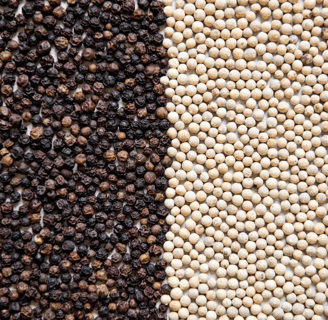White Pepper vs. Black Pepper: Applications and Benefits in Industry
6/26/2024


Understanding the Basics: White Pepper vs. Black Pepper
Pepper is one of the most widely used spices globally, and it comes in two primary forms: white pepper and black pepper. Both varieties are derived from the same plant, but they undergo different processing methods that result in unique characteristics and flavors. Black pepper is harvested when the berries are still green, then cooked and dried to develop its robust flavor. Conversely, white pepper is produced by soaking ripe berries to remove the outer shell, leaving the inner seed. This difference in processing leads to variations in taste, aroma, and even color.
Applications of White and Black Pepper in Industry
In the culinary world, black pepper is often favored for its intense flavor and heat, making it a staple in dishes across various cuisines. Its applications are vast, ranging from seasoning meats and vegetables to enhancing sauces and marinades. On the other hand, white pepper is commonly used in recipes where aesthetics are vital, such as in creamy sauces and light-colored dishes. Its subtle flavor is also beneficial for those who may be sensitive to the heat of black pepper but still desire a peppery taste.
Beyond the kitchen, both types of pepper find applications in other industries. The pharmaceutical industry utilizes their bioactive compounds for potential health benefits such as antioxidant and anti-inflammatory properties. Moreover, white pepper is sometimes preferred in the manufacturing of certain cosmetics for its mild fragrance and skin-friendly qualities, while black pepper remains popular in food additives and flavoring agents.
The Benefits of Using White and Black Pepper
Both white pepper and black pepper provide numerous health benefits, making them valuable not only in culinary applications but also in wellness. Black pepper is known for its piperine content, which can aid in digestion and enhance the bioavailability of nutrients by improving absorption in the body. Additionally, studies suggest that it may possess antimicrobial properties, contributing to food preservation.
Similarly, white pepper is rich in antioxidants and may support respiratory health and reduce inflammation. However, because of its slightly different flavor profile, it typically does not make an ideal substitute for black pepper in all recipes. Thus, understanding the unique benefits of each can help industry professionals choose the right variety for their specific needs.
In conclusion, both white pepper and black pepper have played significant roles in various industries due to their unique characteristics, applications, and health benefits. Whether used in culinary endeavors or other sectors, the comparison of white pepper and black pepper showcases their individuality and versatility. Understanding these differences can lead to optimized usage depending on the intended outcome, whether flavor enhancement or health benefits are the priority.






